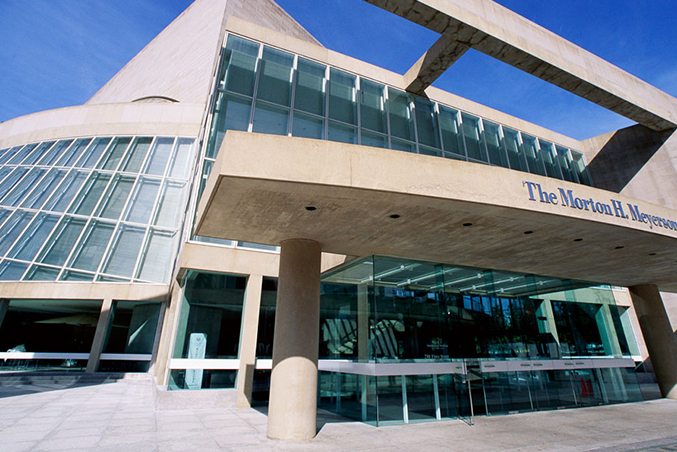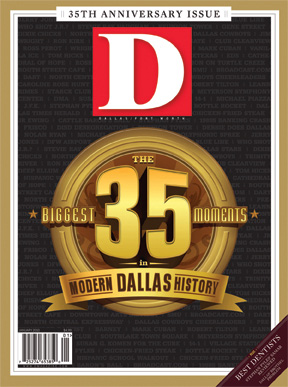We all know and love Jaap van Zweden. But without the efforts of Liener Temerlin and those who joined him, the great conductor wouldn’t have a building in which to conduct. But in September 1989, Dallas got its symphony hall. And the Arts District began to take shape.
The Dallas Museum of Art was the beachhead for what became the Arts District. The trump card was when Dallas decided to build the symphony hall. I was on that board, and for 10 years, those of us who were interested devoted time and energy to raising money. I think, at the time, the City Council, with some exceptions, was very much opposed to raising that money. Being president and chairman, that was my chief responsibility: getting people to put money in.
I think it was more than $120 million, and that has to be a hell of a lot more than that in today’s dollars. (By the way, D Magazine used to run a thumbs-up/thumbs-down feature. Well, I got a thumbs-down from D Magazine for milking the community by raising money for the symphony hall.) Just in terms of selling, I said if we can establish a high-water mark, like the museum did, this portends all kinds of exciting things for Dallas. The analogy I drew was if you had all the money in the world, you’d never have a museum to equal the Metropolitan or the Louvre or the British Museum, because they have all the artwork. But that’s not true with a symphony hall. I said if we build a great symphony hall, we can end up with the best symphony hall and the best orchestra in the world, because that’s all au courant. And that seemed to make sense to everybody.
The symphony hall really became the cornerstone, I think, for what was to follow. The visionaries in Dallas certainly saw that, including Stanley Marcus. The great violinist Isaac Stern said it best. There was a fundraising event, and I asked him to come down. His words were, “The symphony hall shows what Dallas thinks of itself,” which is a great thought, and I think that’s true of this city.
When there was a committee looking into various architects, I.M. Pei said, “I have never built a symphony hall before.” But we had assurances from Pei that he would devote his exclusive time to it, and it turned into a masterpiece.
There was a sort of warfare going on between I.M. Pei and the acoustician, Russell Johnson. There was a constant battle about the floating ceiling. Pei wanted one shape, Johnson wanted another. I finally got them both together and said, “I’m walking out of the room. I’ll be gone for a couple of hours, and if you two [can’t agree]”—and I remember my heart was pounding in my chest as I said this—“we’re going to end up letting both of you go and start all over.” And Dallas Symphony Orchestra executive director Leonard Stone was there at that time. I thought he was going to kill himself. It was costing the symphony money that we raised, because we couldn’t do things until they made that decision. I said, “That’s not going to look good for Dallas, the symphony, or either of you.” They got together, and as a result Dallas is recognized in headlines all over the world.
It was easy to raise money for a while. Then Dallas went into its first slump ever, and it was hard as hell to raise those extra bucks. There’s another story: my wife told me that Ross Perot had called. I was in Chicago, and Ross said, “I understand that you would name the hall after whoever gave $10 million.” He said, “I’ll give you the $10 million, Liener, on three conditions. One, that you follow I.M. Pei’s plans to the nines. Two, that you don’t name it after me: name it after Mort [Meyerson], because he represents EDS, so much of what built the company. I want to recognize the employees. And, three, I want a portrait done and hung in the hall of Margaret McDermott because she taught this city how to give.” And I called Margaret, and Margaret said, “You tell Ross Perot that it’s high time someone said no to the man”—which I love.
As it turned out, I had to call Ross back several times. I told him that I would keep him informed. We didn’t have enough money for the marble floor. That was going to be $2 million or $4 million, I forget what it was. I called Ross, and he said, “I’ll give you two of that if you’ll match it.” I said, “Ross, people cross the street when they see me coming,” because I’d been doing so much fundraising for so long. And he said, “Okay.” So he gave. He didn’t want it published, but he gave $14 million.
American Airlines was one of my accounts, and I called the CEO, Bob Crandall, and they flew that marble in from Rome to make the opening. As the symphony was rehearsing for the grand opening, I was going around asking, “How are the acoustics?” I asked just enough to irritate Johnson, and he said, “Liener, if you stop listening for the acoustics, and start listening to the music, you’ll come to the conclusion all by yourself.”
Today the hall, the acoustics, and the symphony are recognized all over the world.
Liener Temerlin is a longtime Dallas advertising executive and president of Temerlin Consulting.







